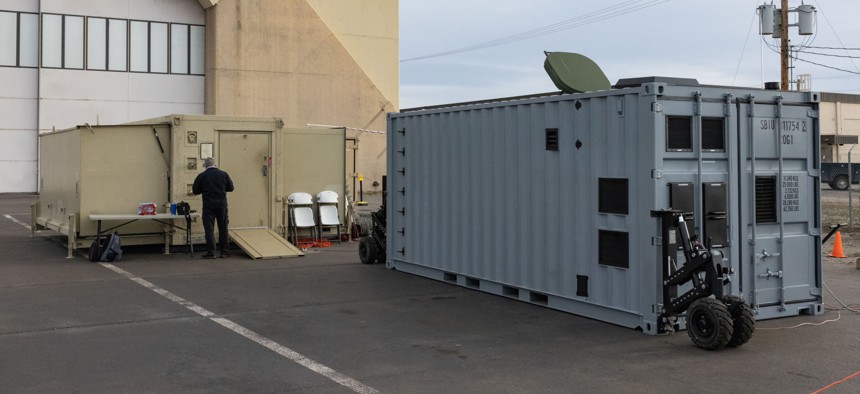
A prototype mobile Secure Compartmented Information Facility delivered to Eielson Air Force Base, Alaska, in May 2023 where it was tested and evaluated for suitability in supporting missions in austere locations. Senior Master Sgt. Charles Givens / DVIDS
Intelligence agencies need to make SCIFs more accessible for employees with disabilities, GAO says
The watchdog examined the facilities agencies use for processing classified information, finding that some barriers that prohibit access remain.
A new report from the Government Accountability Office has found that federal agencies using special facilities handling classified materials have not consistently addressed how to make them more accessible for employees with disabilities.
The public version of the audit, released on Tuesday, examined how 10 intelligence, defense and other agencies manage the accessibility of Sensitive Compartmented Information Facilities, or SCIFs, which are used to store and process high-level classified intelligence.
Because of the sensitive nature of the information, GAO’s public version of the report omitted the agencies’ names when cited for specific examples, information on the agencies conducting SCIF accreditation and other information — though the agencies examined included the CIA, Defense Intelligence Agency, Homeland Security Department, Justice Department, Drug Enforcement Administration, FBI, National Geospatial-Intelligence Agency, National Reconnaissance Office, National Security Agency and the Office of the Director of National Intelligence.
GAO officials said they found that ODNI — which sets standards for managing and constructing SCIFs — had not established guidance for “minimum specifications for common accessibility concerns and addressing accessibility in inspections,” leading to inconsistent approaches to making SCIFs more accessible.
The audit, which ran from June 2022 to January 2024, also found an ODNI database meant to catalog the thousands of SCIFs in use by intelligence agencies collectively known as the Intelligence Community, defense agencies and other agencies was incomplete, lacking consistent detail when compared to the information maintained by SCIF accreditors and internal agency databases.
ODNI and other agencies have also worked in a variety of ways to address physical accessibility, with some improving entryways with touchless or automatic door openers, conducting access inspections, and developing engagement and outreach channels to better understand the improvements that still need to be made, the report said.
But GAO also found that nine SCIFs maintained at five separate agencies still possessed a myriad of physical barriers that could prevent employees with disabilities from accessing them.
“We found instances of obstructions such as tables, chairs and boxes positioned such that an employee in a wheelchair would be unable to move throughout the SCIF unassisted at four of the nine facilities we visited,” the report said. “We also found instances where operable parts within SCIFs—such as door handles, printers, phones or keypads—would be inaccessible to some people with disabilities.”
Eight of the facilities had heavy doors with no automatic openers, as well as difficult-to-use electronic spin locks. Six of the SCIFs also had operable parts — used to insert or withdraw objects or deactivate systems like a keypad or badge reader— that were more than 48 inches above the ground.
Four of the facilities had alarm panels that were more than 48 inches off the ground and another two lacked braille signage detailing the SCIF’s identifiers or its keypads.
“ODNI has guidance on the design and construction of SCIFs, but we found that guidance has limited information on ensuring physical access for people with disabilities,” the report said. “For example, ODNI has not identified minimum specifications for common accessibility concerns in its guidance to the IC, including for automatic door openers, accessible door locks and intrusion detection systems and tactile signage.”
One official also told GAO that even when a SCIF initially meets accessibility requirements, it may fall out of compliance over time through “lapses in maintenance or moveable obstructions.” The report noted that ODNI guidance calls for initial inspections and subsequent annual inspections, but doesn’t specify that an accessibility review should be included.
Access to assistive technologies that could aid employees with disabilities — such as sign language interpretation services on videophones, webcam-based video relay services or the Defense Department’s Computer-Electronic/Accommodations Program — is improving at the agencies examined, GAO officials said.
However, the report noted that there are still ongoing challenges within the SCIFs that impact access to assistive technologies, such as certain security countermeasures that can affect them, reciprocity challenges between agencies that create inconsistent applications and security reviews that can’t keep pace with evolving assistive technologies.
GAO offered four recommendations, including that the Director of National Intelligence helps implement plans for SCIF-accrediting agencies to report data on their inventory in a timely manner, issues new SCIF guidance with minimum specifications for entrance accessibility, issues new guidance that includes accessibility in the annual SCIF security inspection process and issues new guidance to consistently evaluate assistive technologies or medical devices for use in SCIFs, including addressing agency reciprocity.
“ODNI did not provide information on whether it concurred with our recommendations, but provided technical comments,” the report said. “In its technical comments, ODNI expressed concern with some of the language in our recommendations, which we adjusted as appropriate.”
NEXT STORY: How Space Force is raising its cyber defenses







